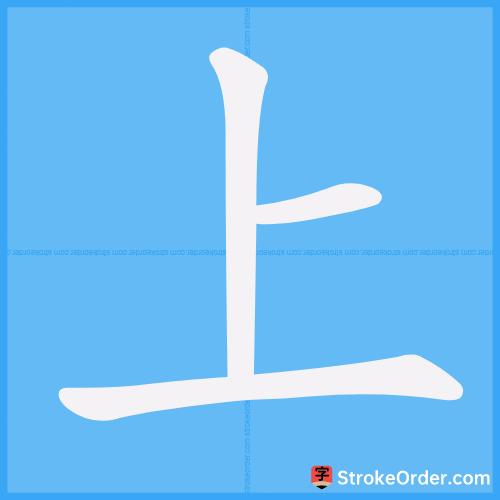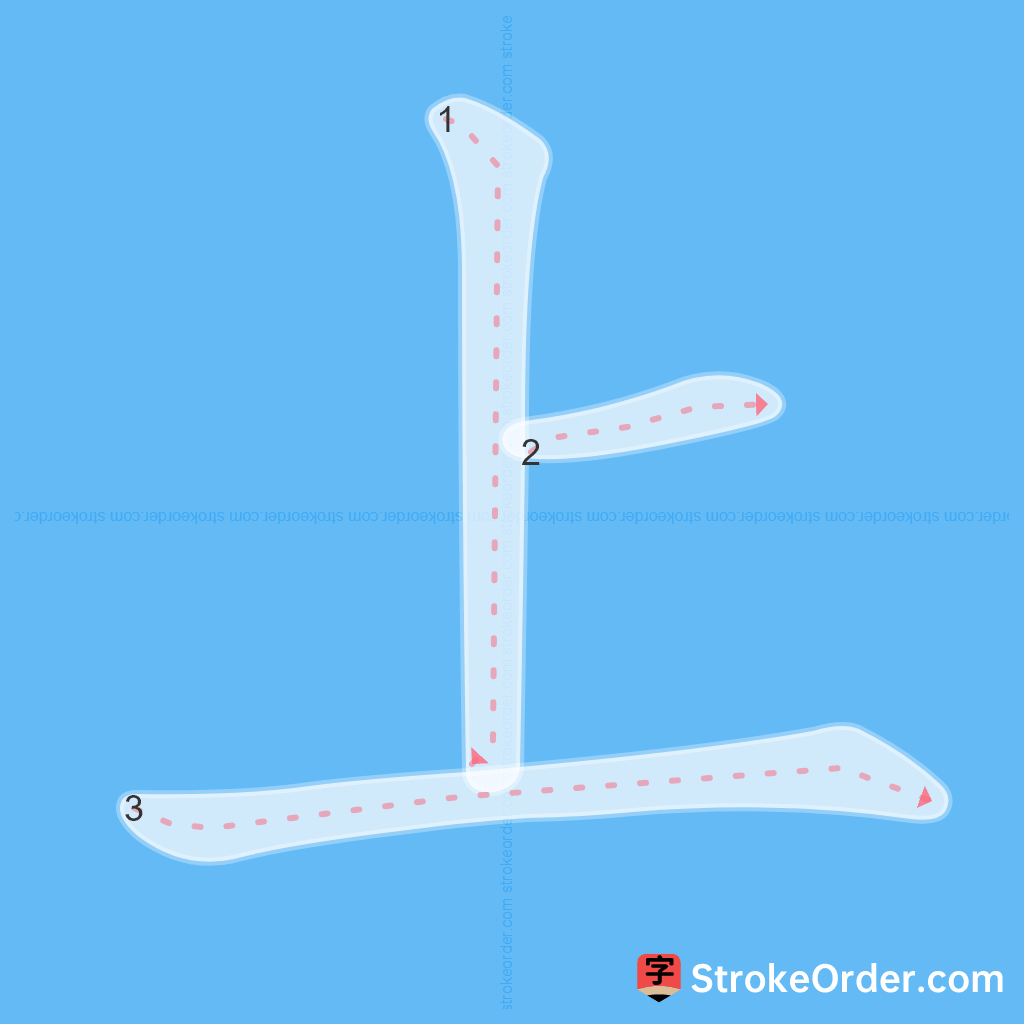上 Stroke Order
Animated Stroke Order of 上

Stroke Order Diagrams for 上

Step-by-Step Handwriting Guide for 上

Learn to Write Chinese Characters with Video Tutorials
Watch the video of writing the Chinese character "上", learn the correct stroke order (笔顺) of the character "上", and master the standard way of writing the character "上".
Free Printable Handwriting Practice with Stroke Order: 上
Printable Writing Practice Worksheet of "上" in Portrait Orientation (Tian Zi Ge)

Printable Writing Practice Worksheet of "上" in Landscape Orientation (Tian Zi Ge)

Information of 上
Pinyin
shàng、 shǎng
Radical
一
Strokes
3 strokes
Usage
★★★★★
Definition
on / on top / upon / first (of two parts) / previous or last (week, etc.) / upper / higher / above / previous / to climb / to go into / above / to go up
上 [shàng]
1. Position that is high up, in contrast to "下" (down):
- Example: 楼上 (upstairs). 上边 (the upper side).
2. Order or time that comes earlier:
- Example: 上古 (ancient times). 上卷 (the first volume).
3. Higher in rank and quality:
- Example: 上等 (first class). 上策 (the best policy). 上乘 (in Buddhism, it generally refers to high literary and artistic realm).
4. From a lower position to a higher one:
- Example: 上山 (to ascend the mountain). 上车 (to get on the vehicle). 上升 (to rise).
5. Go to, arrive at:
- Example: 上街 (to go to the street).
6. Move forward:
- Example: 冲上去 (to charge up).
7. Increase:
- Example: 上水 (to increase water).
8. Install, connect:
- Example: 上刺刀 (to attach a bayonet). 上鞋 (to put on shoes).
9. Put on:
- Example: 上药 (to apply medicine).
10. Conduct or attend an activity on a specified time:
- Example: 上课 (to attend class). 上班 (to go to work).
11. Wind up (as in winding a spring):
- Example: 上弦 (to tighten the string).
12. Enroll, record:
- Example: 上账 (to register accounts).
13. Used after nouns to indicate time, place, or range:
- Example: 晚上 (in the evening). 桌上 (on the table). 组织上 (within the organization).
14. Used after verbs to indicate beginning, continuation, tendency, or completion:
- Example: 爬上来 (to climb up). 锁上 (to lock). 选上代表 (to elect a representative).
15. Reach a certain degree or amount:
- Example: 上年纪 (to get old).
16. In ancient Chinese musical notation, it corresponds to "1" in simplified notation.
上 [shàng] (noun)
- Original meaning: high place; upper side
1. Same as the original meaning:
- [En.] high
2. Heaven; celestial emperor:
- [En.] sky
3. Superior; elders; the upper social classes:
- [En.] superiors; higher-ups; higher authority
4. Monarch; emperor:
- [En.] emperor
5. The musical note "do" in gongche notation:
- [En.] musical note do
6. Time, moment:
- [En.] time
7. Topological word, side, edge:
- [En.] side
上 [shàng] (adjective)
1. Superior, of high rank or good quality:
- [En.] first-class; first-rate; superior
2. Earlier in time or sequence:
- [En.] previous
3. Faraway; distant:
- [En.] faraway; distant
4. Similar to the main or principal meaning:
- [En.] main.
5. Extensive:
- [En.] vast; broad
6. Abundant:
- [En.] rich
上 [shàng] (verb)
1. Ascend; rise; go upward:
- [En.] go up; mount
2. Report; submit:
- [En.] report
3. Present, offer:
- [En.] present to one’s superior
4. Advocate, promote:
- [En.] advocate
5. Submit; pay:
- [En.] pay.
6. Increase; supplement:
- [En.] add.
7. Go forward; advance:
- [En.] advance
8. Go; arrive:
- [En.] go
9. Take office; assume a post:
- [En.] take up.
10. Be on duty:
- [En.] be on duty.
11. Put into; place in:
- [En.] put into
12. Install; attach:
- [En.] install
13. Fall into, suffer:
- [En.] fall into.
14. Accord with:
- [En.] accord with.
15. Teach; learn:
- [En.] conduct; study.
16. Set on fire:
- [En.] fire.
17. Wind up:
- [En.] wind up.
18. An honorific term, implies "to visit":
- [En.] visit.
19. Used after verb to indicate tendency or result of action:
- [En.] action towards or result of action.
20. Remember, bear in mind:
- [En.] remember.
21. Paint, apply:
- [En.] paint.
22. Refer to shǎng.
上 [shàng] (term)
1. A Chinese tone, one of the four tones in Mandarin, the third tone (rising).
上 [shǎng] (term)
- Refers to the above tone, another pronunciation of 上 [shàng].
上 [shǎng] (term)
- Refers to the above tone, another pronunciation of 上 [shàng].
1. Used after nouns indicates being on the surface of an object.
2. Used after nouns indicates within the scope of a certain thing.
3. Indicates a certain aspect.
1. Used after nouns indicates being on the surface of an object:
- Example: 脸上 (on the face). 墙上 (on the wall). 桌子上 (on the table).
2. Used after nouns indicates within the scope of a certain thing:
- Example: 会上 (at the meeting). 书上 (in the book). 课堂上 (in the classroom). 报纸上 (in the newspaper).
3. Indicates a certain aspect:
- Example: 组织上 (in terms of organization). 事实上 (in fact). 思想上 (in terms of thought).
lit. by the thousands and tens of thousands (idiom); untold numbers / innumerable / thousands upon thousands
Input Method for 上
Pinyin
shang4
Wubi
hhgg
Cangjie
ym
Zhengma
ida
Four Corner
21100
Unicode
U+4e0a